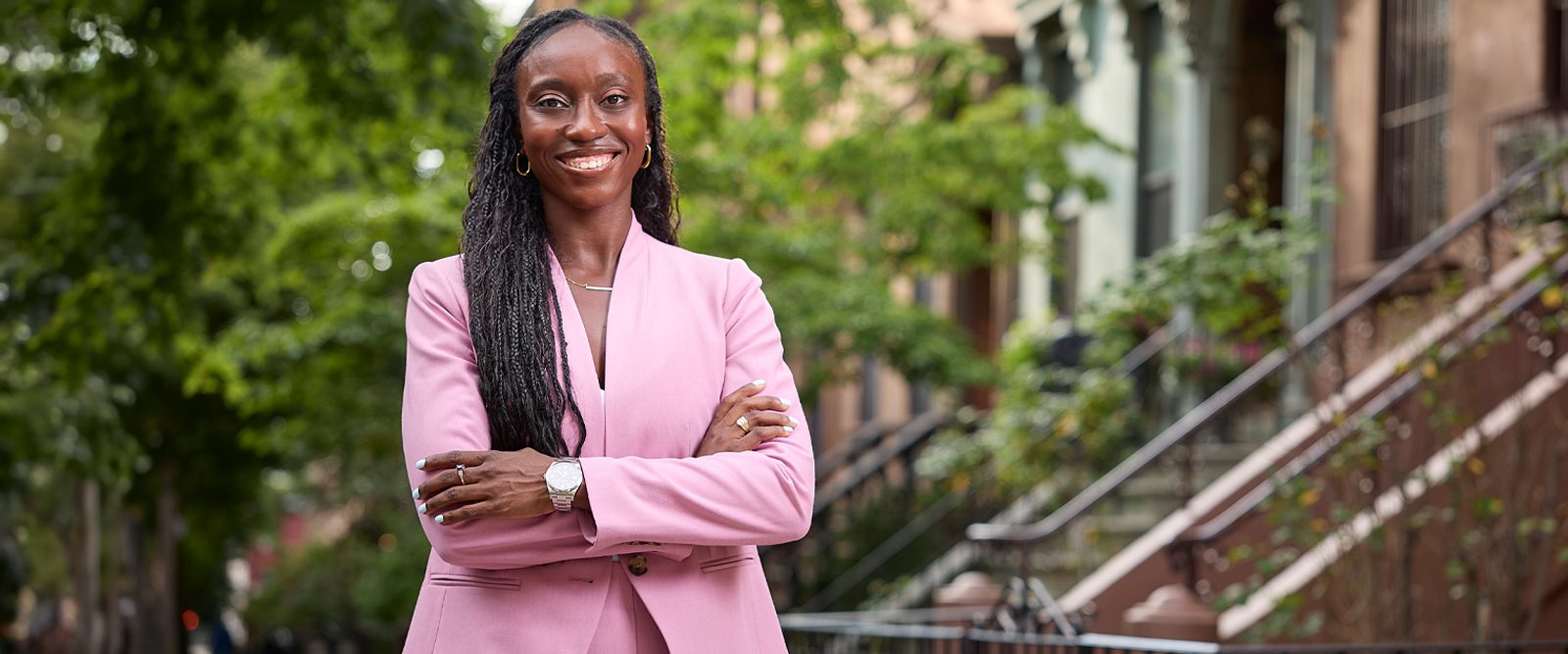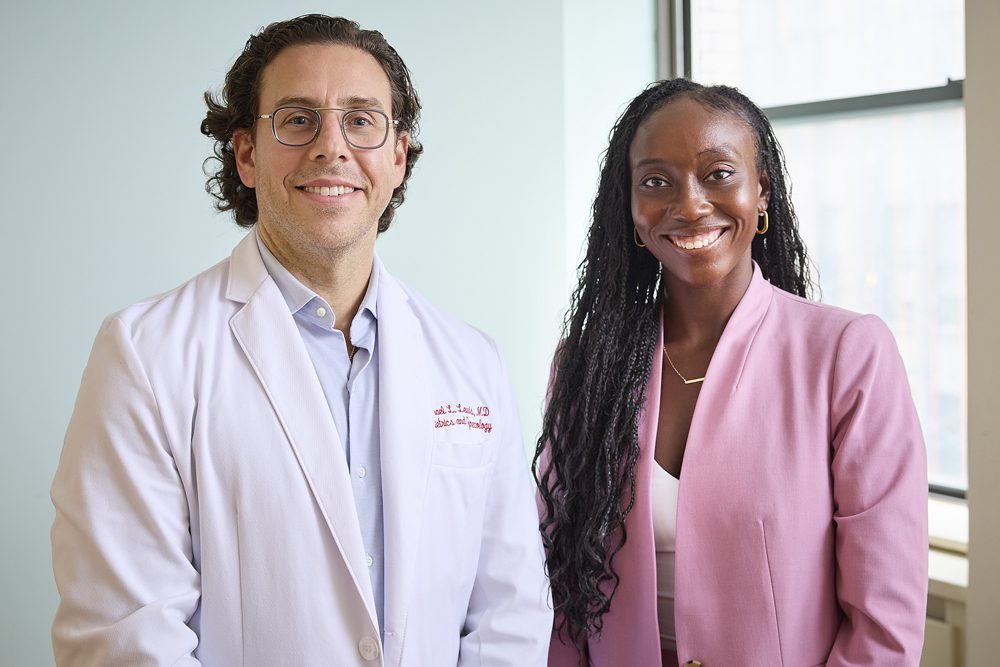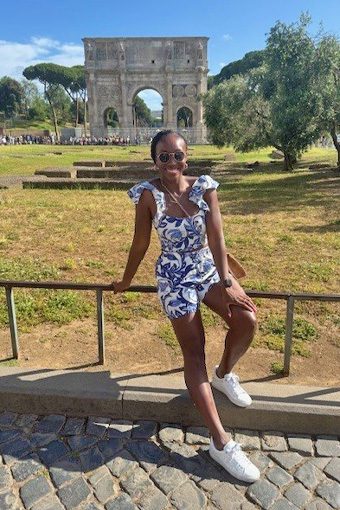After Treatment for a Uterine Fibroid, a Lawyer Encourages Others to “Listen to Your Body”
Ahkianne Wanliss, an avid runner, says her life is back on track after surgery to remove a massive uterine fibroid.

Ahkianne Wanliss, 32, knew something felt off last fall when she felt pressure in her abdomen during the day and lower back pain at night. But the symptoms came and went, so she didn’t think it was anything too serious.
“I’m a runner, and I work out a lot,” says Ahkianne, an attorney who was a sprinter on her college track team, “and I commute long distances for my work, so I stand a lot too. I didn’t attribute it to anything specific, just the general aches and pains of being a New Yorker.”
A short time later when Ahkianne saw her OB-GYN for her annual checkup, he suggested a transvaginal ultrasound, which revealed the true source of the symptoms — a large uterine fibroid. By the new year, her symptoms “started causing one problem after another.” Ahkianne’s stomach was so bloated she stopped wearing fitted or high-waisted clothing. In February, she experienced an extremely painful period, which was occurring every three weeks instead of the usual four.
“That period was probably the most excruciating one I’d ever gone through since I was 12,” Ahkianne recalls.
Perhaps the hardest thing, though, was getting through the workday, as she felt a constant urge to urinate and was afraid to drink water or eat high-water foods.
Ahkianne’s OB-GYN had suggested she see a gynecologic surgeon, and a friend recommended Dr. Michael Lewis, vice chief of Gynecology and director of Minimally Invasive Gynecologic Surgery at NewYork-Presbyterian Brooklyn Methodist Hospital. When they met in late March, Dr. Lewis immediately saw that the problems she described were textbook fibroid symptoms. “Dr. Lewis knew exactly what I was talking about and reassured me that this could be handled swiftly, and I’ll go back to feeling myself again,” Ahkianne says. “I trusted him.”
Dr. Lewis also quickly saw that her fibroid was what he described as “massive.” “With just her physical exam, it felt like a bowling ball fixed within her pelvis,” says Dr. Lewis. An MRI showed that the fibroid was 15 centimeters, about the size of a large grapefruit, and it weighed over 2 pounds.

Dr. Michael Lewis and Ahkianne Wanliss
An All-Too Common Condition
Uterine fibroids are common, noncancerous growths of the uterus. Up to 80% of women will develop fibroids by age 50, according to the National Institutes of Health, and they are especially prevalent in Black women, who are about three times more likely than white women to develop them. Fibroids can range in size from as small as an apple seed to as large as a watermelon; it can also present as a single fibroid or number in the dozens. While some people feel no symptoms and may not require treatment for uterine fibroids beyond monitoring, others are greatly affected, often experiencing unusually heavy periods, and in some cases fertility issues, and may need more intervention.
Fibroids also can cause symptoms that may lead to more serious conditions. In March, Ahkianne had a sudden burst of sharp pain in her right side in the middle of the night “out of nowhere.” It was so intense that she vomited three times.
The next day Ahkianne saw her general practitioner, who thought she might have a kidney stone. Tests and a visit to a kidney specialist showed that both kidneys were swollen and unable to carry urine into the bladder because the fibroid was compressing the drainage tubes called the ureters. The fibroid caused so much pressure that the bladder couldn’t expand to store urine, causing Ahkianne’s urinary frequency, and it also created pressure on Ahkianne’s kidneys. If the fibroid continued to grow, it could lead to kidney failure, Dr. Lewis says. “As it gets bigger and bigger, it’s pushing on her vital organs,” he explains.

Ahkianne Wanliss in Italy shortly after her surgery.
A Path Forward
Dr. Lewis had two goals for Ahkianne’s treatment plan for her uterine fibroid — preservation of her fertility and improving her quality of life.
Dr. Lewis seeks to perform minimally invasive or noninvasive procedures whenever possible, but, because of the size of Ahkianne’s fibroid and her uterus’s lack of mobility — it was “fixed in place” — he recommended an “open approach,” which offered Dr. Lewis greater visibility and control during the fibroid’s removal.
Dr. Lewis performed an abdominal myomectomy — a surgical procedure that involved making a “bikini cut” incision in the lower abdomen — and removed the large fibroid, along with two small ones.
“The fibroid was sitting on top of the uterus, attached to it by a thick stalk like a mushroom,” Dr. Lewis says. It had outgrown its blood supply and was starting to become necrotic, or die, which can cause extreme pain, he adds. Her abdomen measured the size of a five-month pregnancy. “The fibroid was so much bigger than her uterus that it folded her uterus and was fixed in place. It had distorted her anatomy. It took up the entire pelvis.”
Once the surgery was underway, it was a straightforward, 45-minute procedure because of the fibroid’s easy-to-access location.
“The biggest thing I wanted to know was that I would still be able to have children and carry them safely,” Ahkianne says. “Dr. Lewis said when I do have children, it would have to be a C-section because of where the cut is on the uterus. [But] it shouldn’t, God willing, impact my ability to have children down the line.”
Ahkianne spent two days in the hospital followed by two weeks of resting at home. Three-and-a-half weeks after her surgery, she went on a long-planned trip to Italy, which she wasn’t certain she’d be able to do. But Dr. Lewis told her, “We’re going to get you to Italy.”
“I got approval from Dr. Lewis to travel with the only caveat being don’t lift anything heavy,” she says. “So my friends were kind enough to carry my suitcase!”
A Life Back on Track
Today, three months after her surgery, Ahkianne’s life has “pretty much returned to normal.” She commutes to work every day. Her abdomen is once again flat, and she is no longer feeling pressure or pain. Already, her period is occurring like clockwork every four weeks, and “I feel lighter and more energetic,” she says. “I really do love to get out there for a run.”
Dr. Lewis says the best way for people to catch fibroids early is to talk with their doctor about their periods, as any changes in menstruation may be a sign of fibroids.
“People have to talk about their menstrual cycles. That’s how they’ll know if things are off or may be problematic,” he says. “And when they see their OB-GYN, if the doctor isn’t asking the questions, they have to bring it up and say, ‘I’m concerned, what can I do about it?’ When something doesn’t feel right, it probably isn’t.”
Ahkianne says she listens to her body now more than ever, something she advises others to do too, admitting that “as women, we are so quick to explain everything away.”
“Listen to your body, follow your instinct, and get it checked out,” she adds. “Trust your gut, speak up for yourself as quickly as possible and advocate for yourself 100%, and keep pushing to find the best care for you.” She adds that she is grateful for Dr. Lewis, not only because she got her life back, but “for hearing my concerns and knowing that what I was feeling wasn’t made up in my head. And for that, I’m forever thankful.”
Additional Resources
Learn more about treatments for uterine fibroids at NewYork-Presbyterian.
